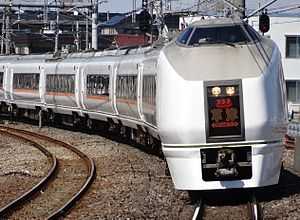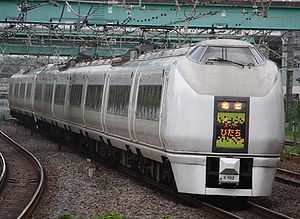651 series
| 651 series | |
|---|---|
|
A 651-0 series EMU on a Super Hitachi service, July 2008 | |
| In service | 1989–Present |
| Manufacturer | Kawasaki Heavy Industries |
| Built at | Hyogo |
| Replaced | 485 series |
| Constructed | 1988–1992 |
| Refurbishment | October 2000–December 2002 |
| Scrapped | 2013– |
| Number built | 99 vehicles (18 sets) |
| Number in service | 95 vehicles (17 sets) |
| Number scrapped | 4 vehicles (1 set) |
| Formation | 4/7 cars per trainset |
| Operator | JR East |
| Depot(s) | Katsuta, Omiya |
| Specifications | |
| Car body construction | Steel |
| Car length | 21,500 mm (70 ft 6 in) (end cars), 21,100 mm (69 ft 3 in) intermediate cars[1] |
| Width | 2,900 mm (9 ft 6 in) |
| Maximum speed | 130 km/h (80 mph)[1] |
| Traction system | Resistor control + field system superimposed field excitation control |
| Acceleration | 1.95 km/h/s |
| Deceleration | 5.2 km/h/s |
| Electric system(s) | 1,500 V DC / 20 kV AC (50Hz) |
| Current collection method | Overhead catenary |
| Bogies | DT56 (motor), T241 (trailer) |
| Safety system(s) | ATS-P, ATS-Ps |
| Track gauge | 1,067 mm (3 ft 6 in) |
The 651 series (651系) is an AC/DC dual-voltage electric multiple unit (EMU) type operated by East Japan Railway Company (JR East) in Japan since March 1989.[1]
Trains originally operated as 7+4-car formations on Super Hitachi limited express services between Ueno in Tokyo and Sendai via the Jōban Line, but were withdrawn from regular scheduled services from the start of the revised timetable on 16 March 2013.[2] The majority of the fleet was subsequently modified to become the 651-1000 series, and re-employed on Akagi and Kusatsu limited express services from March 2014.
Variants
- 651-0 series: Original (nine 7-car and nine 4-car) AC/DC sets built from 1989
- 651-1000 series: 7-car and 4-car DC-only sets modified from 651-0 series between 2013 and 2014
Operations
As of April 2014, the remaining 651-0 series sets are mostly kept in storage, with two 7+4-car formations assigned to Fresh Hitachi services on the Joban Line.[3] The 651-1000 series sets are used on Akagi, Swallow Akagi, and Kusatsu limited express services.[4]
Formations
651-0 series
As of 1 April 2014, the fleet of original 651-0 series trainsets consists of three (out of the original nine) seven-car sets (K102, 103, 105) and five (out of the original nine) four-car sets (K201, 202, 204, 205, 205), based at Katsuta Depot.[3]
7-car sets
The seven-car sets, K101 to K109, are formed as follows, with four motored ("M") cars and three non-powered trailer ("T") cars, and car 1 at the Ueno (southern) end.[3]
| Car No. | 1 | 2 | 3 | 4 | 5 | 6 | 7 |
|---|---|---|---|---|---|---|---|
| Designation | Tc2 | M'2 | M2 | Ts | M'1 | M1 | Tc1 |
| Numbering | KuHa 650 | MoHa 650-100 | MoHa 651-100 | SaRo 651 | MoHa 650 | MoHa 651 | KuHa 651 |
- Cars 2 and 5 are each fitted with one PS26 lozenge-type pantograph.[3]
- Cars 1, 3, 4, and 6 have toilets.[3]
4-car sets
The four-car sets, K201 to K209, are formed as follows, with two motored ("M") cars and two non-powered trailer ("T") cars, and car 8 at the Ueno (southern) end.[3]
| Car No. | 8 | 9 | 10 | 11 |
|---|---|---|---|---|
| Designation | Tc2 | M'1 | M1 | Tc1 |
| Numbering | KuHa 650 | MoHa 650 | MoHa 651 | KuHa 651-100 |
651-1000 series

As of 1 April 2014, the fleet consists of six seven-car sets (numbered OM201 to OM206) and three four-car sets (numbered OM301 to OM303), all based at Omiya Depot.[3]
7-car sets
The seven-car sets, OM201 to OM206, are formed as follows, with four motored ("M") cars and three non-powered trailer ("T") cars, and car 1 at the Ueno (southern) end.[4][3]
| Car No. | 1 | 2 | 3 | 4 | 5 | 6 | 7 |
|---|---|---|---|---|---|---|---|
| Designation | Tc2 | M'2 | M2 | Ts | M'1 | M1 | Tc1 |
| Numbering | KuHa 650-1000 | MoHa 650-1100 | MoHa 651-1100 | SaRo 651-1000 | MoHa 650-1000 | MoHa 651-1000 | KuHa 651-1000 |
| Seating capacity | 52 | 64 | 58 | 36 | 68 | 64 | 56 |
- Cars 2 and 5 are each fitted with one PS33D single-arm pantograph.[3]
- Cars 1, 3, 4, and 6 have toilets.[3]
4-car sets
The four-car sets, OM301 to OM303, are formed as follows, with two motored ("M") cars and two non-powered trailer ("T") cars, and car 8 at the Ueno (southern) end.[4][3]
| Car No. | 8 | 9 | 10 | 11 |
|---|---|---|---|---|
| Designation | Tc2 | M'1 | M1 | Tc |
| Numbering | KuHa 650-1000 | MoHa 650-1000 | MoHa 651-1000 | KuHa 651-1100 |
| Seating capacity | 52 | 68 | 64 | 56 |
Interior
Internally, Green car (first class) accommodation is arranged 2+1 abreast with a seat pitch of 1,160 mm (46 in), and Standard class is arranged 2+2 abreast with a seat pitch of 970 mm (38 in).[1][5]
-
Green class seating
-

Interior view of standard class car
History
The 651 series trains were introduced on new Super Hitachi limited services between Ueno and Sendai on 11 March 1989,[1] and the trains received the 33rd Blue Ribbon Award presented annually in Japan since 1958 by the Japan Railfan Club.[6]
From 2 December 2000, the Green car (car 4) was made entirely non-smoking, and the internal partitions were removed between December 2000 and January 2001.[7] Three seats were added to the Green car in June 2004, increasing the seating capacity to 36.[7] All cars became no-smoking from the start of the revised timetable on 18 March 2007.[7] The refreshment vending machines were discontinued from 31 March 2008.[7]
From the start of the revised timetable on 17 March 2012, six pairs of 651 series trains were removed from service and put into storage, replaced by new 10-car E657 series EMUs on Super Hitachi services.[8] The entire fleet was replaced by the start of the revised timetable on 16 March 2013, but the sets were however retained for seasonal and additional workings.[2]
From 1 October 2013, one 11-car 651 series formation was brought back into service for use on two Fresh Hitachi services daily while the E657 series fleet undergoes modification work to add LED seat reservation status indicators above each seat.[9] This is scheduled to continue until around March 2015.[9]
651-1000 series conversions
Between late 2013 and early 2014, a number of 651 series sets were modified and renumbered 651-1000 series for use on Akagi and Kusatsu limited express services from the start of the revised timetable on 15 March 2014, replacing ageing 185 series EMUs.[4][9] The modifications included disconnecting (but not removing) the original AC electrical equipment, replacing the original PS26 lozenge-type pantographs with the same PS33D single-arm pantographs used on E233 series suburban EMUs, and adding an orange bodyside stripe below the windows.[4] No changes were made to the interiors.[4]
Fleet details
The delivery, refurbishment, and conversion dates for the fleet are as shown below. All sets were originally built by Kawasaki Heavy Industries in Hyogo.[10][4]
7-car sets
| Set | Delivered | Refurbished | Renumbered | Date modified | Location modified |
|---|---|---|---|---|---|
| K101 | 20 December 1988 | 2 October 2001 | OM201 | 12 March 2014 | Koriyama |
| K102 | 11 January 1989 | 3 August 2001 | |||
| K103 | 6 February 1989 | 23 July 2002 | |||
| K104 | 15 February 1989 | 22 November 2000 | OM202 | 5 March 2014 | Omiya |
| K105 | 28 February 1989 | 16 February 2001 | |||
| K106 | 28 December 1989 | 18 June 2002 | OM203 | 24 January 2014 | Koriyama |
| K107 | 19 February 1990 | 14 February 2002 | OM204 | 14 November 2013 | Koriyama |
| K108 | 3 March 1990 | 4 October 2000 | OM205 | 6 December 2013 | Koriyama |
| K109 | 26 January 1992 | 21 November 2001 | OM206 | 7 October 2013 | Koriyama |
4-car sets
| Set | Delivered | Refurbished | Renumbered | Date modified | Location modified | Withdrawn |
|---|---|---|---|---|---|---|
| K201 | 6 February 1989 | 13 June 2001 | ||||
| K202 | 15 February 1989 | 3 March 2001 | ||||
| K203 | 28 February 1989 | 27 September 2002 | 11 September 2013[11] | |||
| K204 | 28 December 1989 | 20 March 2002 | ||||
| K205 | 1 February 1990 | 28 October 2002 | ||||
| K206 | 1 February 1990 | 24 October 2001 | OM301 | 21 February 2014 | Koriyama | |
| K207 | 19 February 1990 | 28 November 2002 | ||||
| K208 | 3 March 1990 | 13 December 2001 | OM302 | 3 April 2014 | Koriyama | |
| K209 | 26 January 1992 | 26 December 2002 | OM303 | 5 March 2014 | Koriyama | |
References
- ↑ 1.0 1.1 1.2 1.3 1.4 JR全車輌ハンドブック2009 [JR Rolling Stock Handbook 2009]. Japan: Neko Publishing. 2009. p. 187-188. ISBN 978-4-7770-0836-0.
- ↑ 2.0 2.1 "651系・E653系が定期運用から離脱" [651 series and E653 series removed from regular services]. Japan Railfan Magazine Online (in Japanese). Japan: Koyusha Co., Ltd. 16 March 2013. Retrieved 20 March 2013.
- ↑ 3.0 3.1 3.2 3.3 3.4 3.5 3.6 3.7 3.8 3.9 3.10 3.11 3.12 3.13 3.14 JR電車編成表 2014夏 [JR EMU Formations - Summer 2014]. Japan: Kotsu Shimbunsha. 30 May 2014. p. 41, 65. ISBN 978-4-330-46614-9.
- ↑ 4.0 4.1 4.2 4.3 4.4 4.5 4.6 651系1000番台 [651-1000 series]. Japan Railfan Magazine (in Japanese) (Japan: Koyusha Co., Ltd.) 54 (642): p.82-84. October 2014.
- ↑ 常磐線特急に新型車両を導入! [New trains to be introduced on Jōban Line limited express services] (PDF) (in Japanese). East Japan Railway Company. 7 December 2010. Retrieved 7 December 2010.
- ↑ JR特急列車年鑑2013 [Limited Express Annual 2013]. Tokyo, Japan: Ikaros Publications Ltd. 20 December 2012. p. 70-71. ISBN 978-4-86320-654-0.
- ↑ 7.0 7.1 7.2 7.3 JR電車編成表 2009夏 [JR EMU Formations - Summer 2009]. Japan: Kotsu Shimbunsha. June 2009. p. 43. ISBN 978-4-330-06909-8.
- ↑ "E657系投入にともなう651・E653系の動き" [651/E653 series changes following E657b series introduction]. Japan Railfan Magazine (Japan: Koyusha Co., Ltd.) 52 (613): p.70–71. May 2012.
- ↑ 9.0 9.1 9.2 Matsumoto, Norihisa (April 2014). 転用進むJR特急車 [JR Limited Express Trains and Continuing Reassignment]. Japan Railfan Magazine (in Japanese) (Japan: Koyusha Co., Ltd.) 54 (636): p.33-35.
- ↑ Shibata, Togo (March 2013). "さよなら651系〈スーパーひたち〉 E653系〈フレッシュひたち〉" [Farewell 651 series "Super Hitachi" & E653 series "Fresh Hitachi"]. Rail Magazine (in Japanese) (Japan: Neko Publishing Co., Ltd.) (354): p.39–45.
- ↑ JR電車編成表 2014冬 [JR EMU Formations - Winter 2014]. Japan: Kotsu Shimbunsha. 1 December 2013. p. 355. ISBN 978-4-330-42413-2.
External links
| Wikimedia Commons has media related to 651 series. |
- 651 series Akagi/Kusatsu (Japanese)
| |||||||||||||||||||||||||||||||||||||

